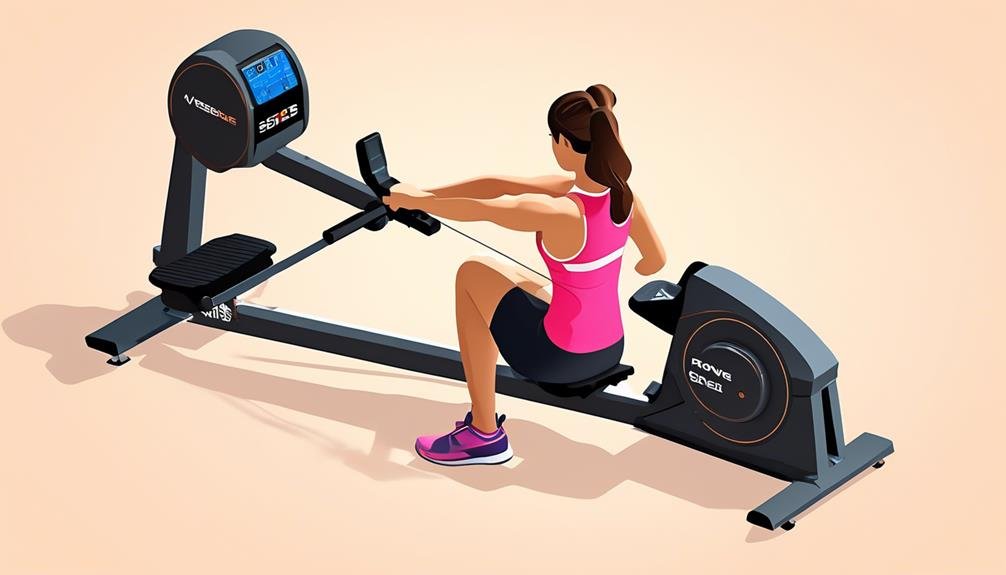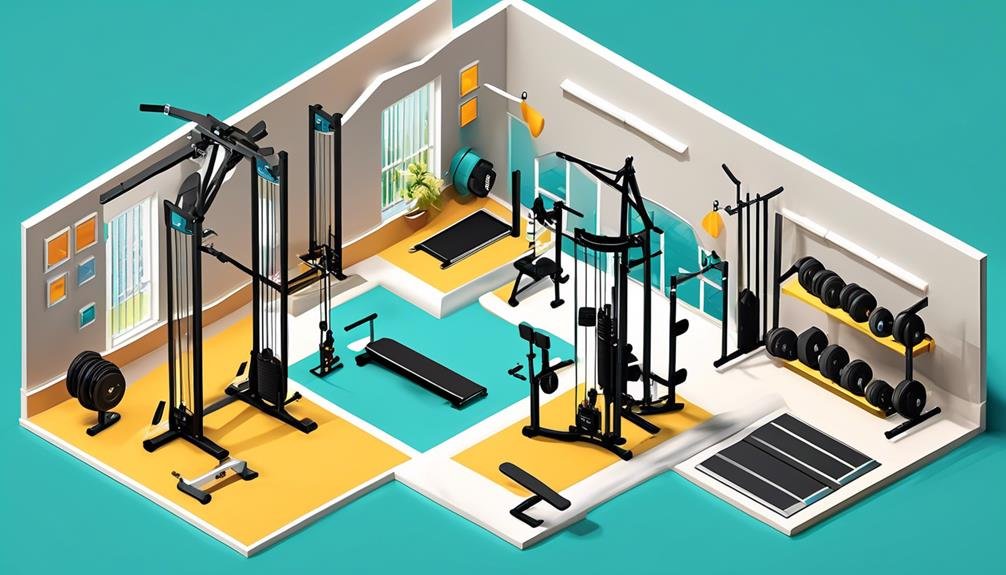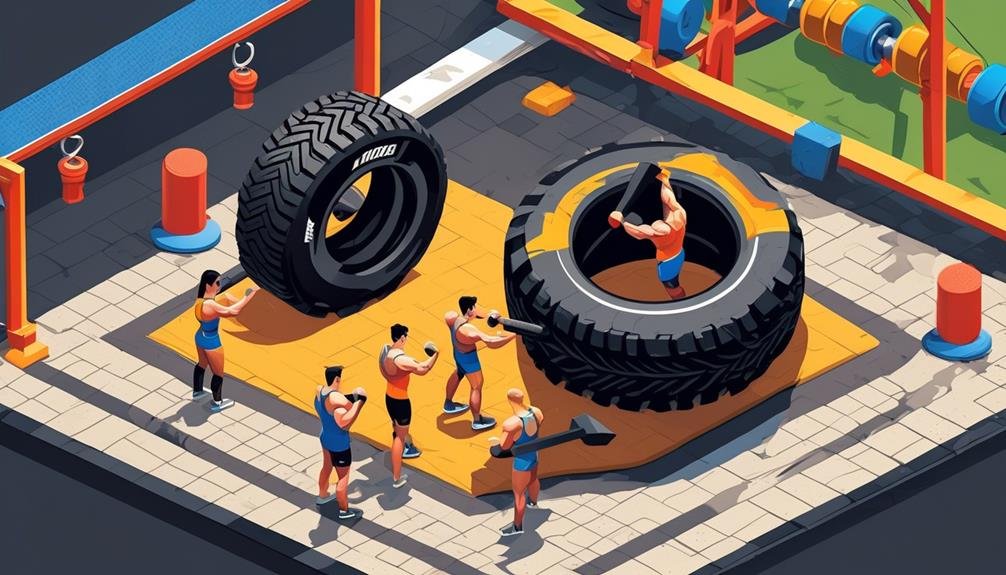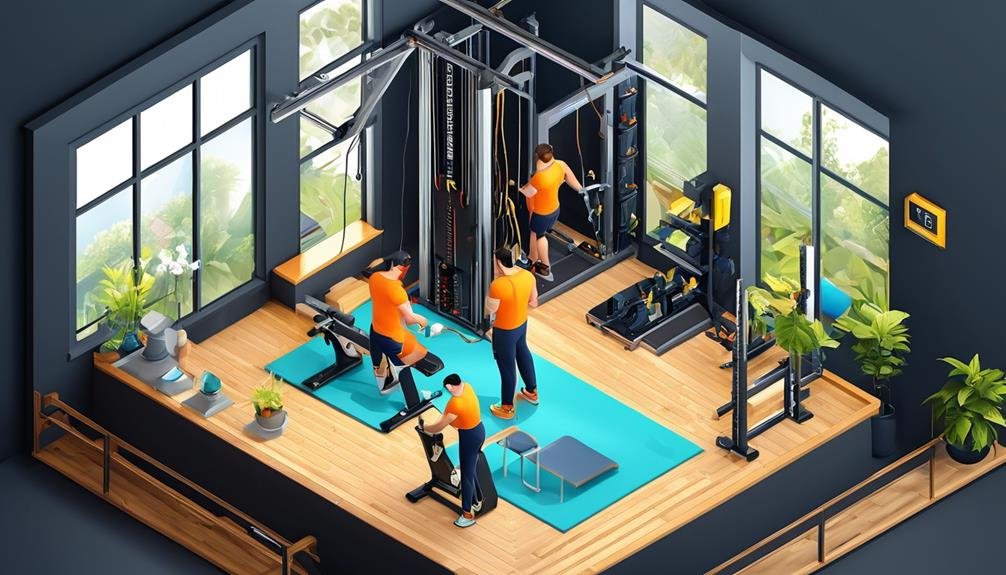Disclaimer: This content is for informational purposes only and does not replace professional medical advice, diagnosis, or treatment. Always consult a qualified healthcare provider before beginning any new exercise program.
So, you’ve decided to take your rowing workouts to the next level and incorporate some HIIT training. But where do you start?
Adjusting the settings on your rowing machine is key to achieving the intensity and challenge you’re looking for. In this discussion, we’ll explore the various adjustments you can make to maximize your HIIT workouts.
From understanding resistance levels and damper settings to finding the right foot strap position and customizing the display metrics, we’ll cover it all.
Get ready to elevate your rowing game and take your fitness journey to new heights.
Key Takeaways
- Resistance level determines intensity, so adjust it based on your fitness level and goals.
- Experiment with damper settings to find challenging yet sustainable settings that mimic the resistance of a heavier boat.
- Increase stroke rate to increase intensity and aim for a range of 26 to 32 strokes per minute.
- Customize display metrics on the rowing machine to track important information and personalize your HIIT workouts.
Understanding the Resistance Levels
To optimize your rowing machine workouts, it’s essential to have a clear understanding of the resistance levels and how to adjust them effectively. The resistance level on a rowing machine determines the intensity of your workout. By adjusting the resistance, you can make your workouts more challenging or less demanding, depending on your fitness goals.
Most rowing machines have a set of numbered settings that indicate the resistance level. These settings can range from 1 to 10 or even higher, depending on the machine. As a general rule, the higher the number, the greater the resistance. However, keep in mind that the resistance levels may vary between different rowing machine models, so it’s important to consult your machine’s user manual for specific instructions.
To adjust the resistance level, locate the resistance setting on your rowing machine. This is typically a dial, lever, or digital display. Follow the instructions provided by the manufacturer to increase or decrease the resistance. Some rowing machines also offer preset programs that automatically adjust the resistance level throughout your workout, adding variety and challenge to your routine.
Remember, the resistance level should be adjusted based on your fitness level and goals. If you’re a beginner, start with a lower resistance and gradually increase it as you become more comfortable and stronger. For a more intense workout, increase the resistance to push your muscles and cardiovascular system to work harder.
Understanding the resistance levels on your rowing machine will allow you to tailor your workouts to your fitness level and goals effectively. By adjusting the resistance, you can challenge yourself, build strength, and improve your overall fitness. Take the time to familiarize yourself with your rowing machine’s resistance settings, and you’ll be on your way to achieving optimal results from your workouts.
Adjusting the Damper Setting
Now let’s explore how to adjust the damper setting on your rowing machine to further customize your workout.
The damper setting on a rowing machine controls the airflow into the flywheel, affecting the resistance you feel while rowing. Adjusting the damper setting can help you achieve the desired intensity and challenge during your HIIT workouts.
Here are three key points to keep in mind:
- Higher damper setting: Increasing the damper setting means more air enters the flywheel, resulting in a heavier resistance. This setting mimics rowing on a heavier boat and requires more force to move the flywheel. It can be beneficial for building strength and power but may require more effort and impact your rowing technique.
- Lower damper setting: Decreasing the damper setting reduces the amount of air entering the flywheel, making the resistance lighter. This setting replicates rowing on a lighter boat and allows for a faster stroke rate. It’s suitable for improving cardiovascular endurance and can help maintain proper rowing form.
- Personal preference: The ideal damper setting varies from person to person. Experiment with different settings to find the one that feels challenging yet sustainable for your fitness level and goals. Remember to focus on maintaining proper technique and engaging your muscles effectively throughout your HIIT workouts.
Setting the Stroke Rate for Intensity
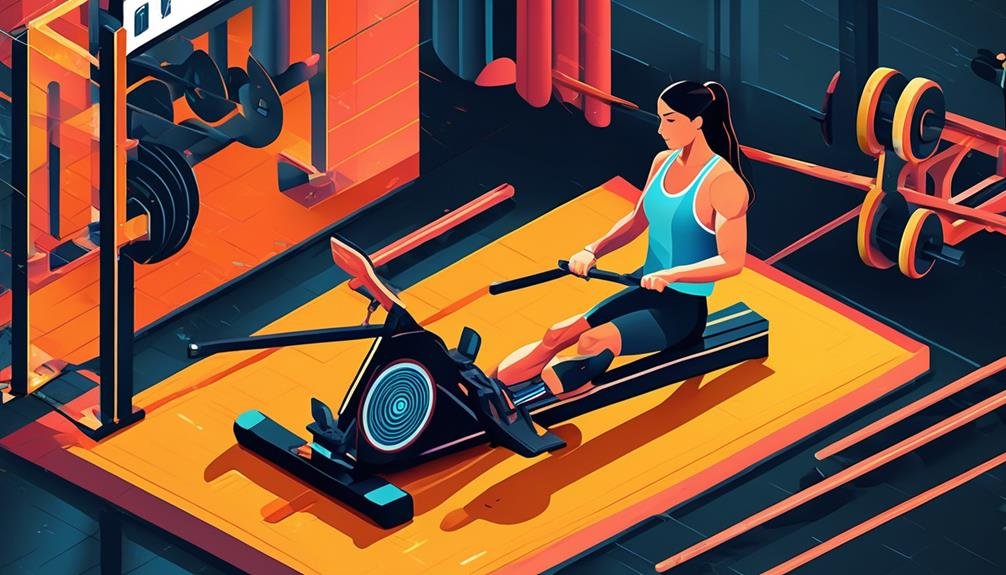
Setting the stroke rate appropriately is crucial for maximizing the intensity of your rowing machine HIIT workouts. The stroke rate refers to the number of strokes you take per minute. To increase the intensity of your workout, you need to increase the stroke rate. However, it’s important to find a balance between speed and power to avoid sacrificing form and efficiency.
Start by setting a baseline stroke rate that feels comfortable for you. This is usually around 20 to 24 strokes per minute. As you become more comfortable with the movement and build up your strength, gradually increase the stroke rate. Aim for a range of 26 to 32 strokes per minute for your HIIT workouts. This will challenge your cardiovascular system and engage your muscles more intensely.
Keep in mind that rowing at a higher stroke rate requires more power and strength. Focus on generating power with your legs and engaging your core and back muscles to maintain a strong and efficient stroke. It’s also important to maintain proper technique and avoid rushing through the motions.
Experiment with different stroke rates during your workouts to find the intensity level that works best for you. Remember to listen to your body and adjust accordingly.
Finding the Right Foot Strap Position
Positioning your feet correctly in the foot straps is essential for maximizing your rowing machine HIIT workouts. To find the right foot strap position, follow these steps:
- Sit on the rowing machine with your feet in the foot straps.
- Make sure the straps are securely fastened around your feet to prevent slipping.
- Position your feet so that the balls of your feet are resting on the footplates.
- Align your toes with the foot straps, ensuring that they’re centered and not too far forward or backward.
- Adjust the strap tightness.
- The straps should be snug enough to hold your feet in place but not too tight that they restrict movement or cause discomfort.
Check that your feet feel secure and stable in the foot straps.
Pay attention to your foot angle.
- Keep your feet flexed and your toes pointing slightly upward.
- Avoid pointing your toes downward as it can strain your calf muscles.
Finding the right foot strap position will help you maintain proper form, engage the correct muscles, and prevent injuries during your rowing machine HIIT workouts. Experiment with different positions to find what feels most comfortable and effective for you.
Customizing the Display Metrics

To personalize your rowing machine experience, you can customize the display metrics to track the specific information that matters most to you. This allows you to monitor your progress and stay motivated during your HIIT workouts. Most rowing machines offer a variety of display options that can be adjusted to meet your preferences. Here is a table that outlines some common display metrics and their meanings:
| Metric | Description | Purpose |
|---|---|---|
| Time | Shows the duration of your workout | Helps you track the length of your sessions |
| Distance | Displays the total distance rowed | Allows you to measure how far you’ve rowed |
| Strokes Per Min | Indicates the number of strokes you complete | Helps you maintain a consistent rowing pace |
| Calories | Shows the estimated amount of calories burned | Allows you to track your energy expenditure during the workout |
Incorporating Interval Training Programs
To enhance the effectiveness of your HIIT workouts, incorporating interval training programs on your rowing machine can provide a dynamic and challenging workout experience. Interval training involves alternating between high-intensity bursts and periods of active recovery.
By incorporating interval training programs into your rowing machine workouts, you can maximize your calorie burn, increase your cardiovascular endurance, and improve your overall fitness level.
Here are three ways you can incorporate interval training programs on your rowing machine:
- Pre-set Programs: Many rowing machines come with pre-set interval training programs that are designed to challenge you and push you to your limits. These programs usually include a combination of high-intensity intervals and recovery periods, allowing you to focus on your workout without having to manually adjust the settings.
- Manual Intervals: If your rowing machine doesn’t have pre-set programs, you can manually create your own interval training program. Set a timer or use a stopwatch to track your intervals and adjust the resistance and stroke rate accordingly. Start with shorter intervals and gradually increase the duration and intensity as you progress.
- HIIT Apps or Online Workouts: There are numerous HIIT apps and online workouts available that specifically cater to rowing machine interval training. These programs provide guided workouts with varying intensity levels, making it easy for you to follow along and challenge yourself.
Incorporating interval training programs on your rowing machine can take your HIIT workouts to the next level, helping you achieve your fitness goals faster and more effectively.
Frequently Asked Questions
How Do I Properly Warm up Before Starting a HIIT Workout on a Rowing Machine?
To properly warm up before starting a HIIT workout on a rowing machine, start with a five-minute easy rowing session. Gradually increase your intensity, focusing on proper technique. This will prepare your muscles and prevent injury.
Are There Any Specific Rowing Techniques I Should Follow During a HIIT Workout?
To optimize your HIIT workout on a rowing machine, focus on maintaining proper form by keeping your back straight, engaging your core, and using your legs, back, and arms in a coordinated motion.
Can I Use a Heart Rate Monitor to Track My Intensity During a HIIT Workout on a Rowing Machine?
Yes, you can use a heart rate monitor to track your intensity during a HIIT workout on a rowing machine. It’s a great way to ensure you’re pushing yourself and staying within your target heart rate zone.
What Are Some Common Mistakes to Avoid When Doing HIIT Workouts on a Rowing Machine?
To avoid common mistakes during HIIT workouts on a rowing machine, focus on maintaining proper form, gradually increasing intensity, and listening to your body. Pay attention to your breathing, control your strokes, and don’t push yourself too hard too soon.
How Often Should I Incorporate HIIT Workouts Into My Rowing Machine Routine for Optimal Results?
To achieve optimal results, incorporate HIIT workouts into your rowing machine routine 2-3 times per week. This frequency allows for sufficient intensity and recovery, maximizing the benefits of high-intensity interval training.
Conclusion
In conclusion, adjusting the settings on your rowing machine for HIIT workouts is crucial for achieving optimal intensity and performance.
Understanding the resistance levels, adjusting the damper setting, setting the stroke rate, finding the right foot strap position, and customizing the display metrics are all important factors to consider.
By incorporating interval training programs, you can maximize the benefits of your HIIT workouts and effectively improve your fitness level.
